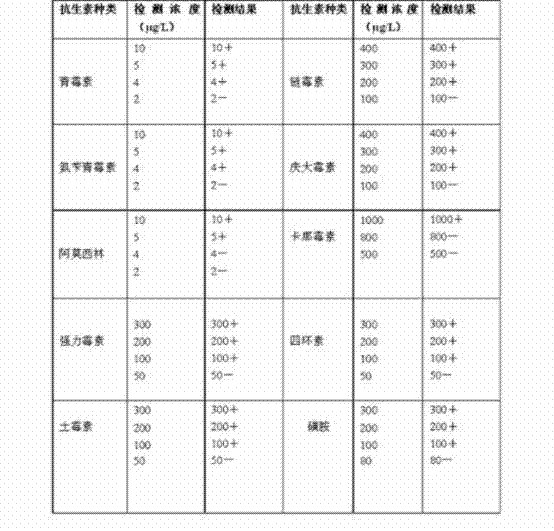Indicator strain and application thereof
An indicator bacteria and indicator technology, applied in the field of microorganisms, can solve the problems of high price, high detection cost, increase the detection cost of milk enterprises, etc., and achieve the effect of short detection time and low cost
- Summary
- Abstract
- Description
- Claims
- Application Information
AI Technical Summary
Benefits of technology
Problems solved by technology
Method used
Image
Examples
Embodiment 1
[0025] The standard for using the kit of the present invention to detect and determine that it is a certain antibiotic is: purchase milk powder that has been tested to contain no antibiotic residues, and restore it to milk with a concentration of 13%. Prepare milk containing different concentrations of antibiotics, such as milk containing 2 μg / L penicillin, when the kit detects milk containing 2 μg / L penicillin, it is positive, which means that the kit can detect penicillin sensitively.
[0026] Another example is to use a kit to detect the milk containing a certain concentration of antibiotics (milk containing 4 μg / L penicillin, milk containing μg / L ampicillin, milk containing 100 μg / L sulfonamide). Take 100 microliters of the above-prepared milk samples and add them to the microwells of the kit respectively, and take milk samples without antibiotic residues as a control. Seal the micropores with plastic film or scotch tape and keep warm in a water bath at 60-65°C for 2.5 hou...
Embodiment 2
[0035] Step 1: Dip a ring of indicator strains preserved on a slant ( Anoxybacillus sp. FHB009), inoculate it into liquid beef extract peptone medium to activate the strain, culture it at 50°C, 100rpm / min for 12h, and make seed liquid;
[0036] In terms of mass percentage, the formula of the beef extract-peptone medium is: 0.1% beef extract, 0.5% peptone, and 0.1% sodium chloride, and the pH is adjusted to 5; after stirring evenly, sterilize and cool in an autoclave to 50- 60 ℃ room temperature standby;
[0037] Step 2: Spread the above seed liquid evenly on the spore-producing solid medium at a volume ratio of 1:200, and cultivate it in an incubator at 50°C. After 3 days of cultivation, staining and microscopic examination, when the spore formation rate reaches more than 90% stop culturing and collect spores;
[0038] In terms of mass percentage, the formula of the spore-producing solid medium is: beef extract 0.1%-, soybean peptone 0.1%, NaCL 0.2%, MnSO 4 0.001%, pH5, ag...
Embodiment 3
[0047] Step 1: Dip a ring of indicator strains preserved on a slant ( Anoxybacillus sp. FHB009), inoculate it into liquid beef extract peptone medium to activate the bacteria, and cultivate it at 60°C and 100rpm for 12h to make a seed liquid; the formula of the beef extract peptone medium is: beef extract 1%, peptone 5 %, sodium chloride 0.1%, pH 7; after stirring evenly, sterilize in an autoclave and cool to room temperature of 60°C for later use.
[0048] The second step: inoculate the seed liquid into the spore-producing solid medium, and cultivate it in a high-temperature incubator at 50°C. After 3 days of cultivation, staining and microscopic examination, stop the cultivation when the spores reach more than 90%, and collect the spores and spore suspension. The formula of the spore-producing medium is: beef extract 1%, soybean peptone 1%, NaCL 0.2%, MnSO 4 0.01%, pH8, agar 2%. After stirring evenly, sterilize and cool to 60°C in an autoclave and pour it into a plate for...
PUM
 Login to View More
Login to View More Abstract
Description
Claims
Application Information
 Login to View More
Login to View More - R&D
- Intellectual Property
- Life Sciences
- Materials
- Tech Scout
- Unparalleled Data Quality
- Higher Quality Content
- 60% Fewer Hallucinations
Browse by: Latest US Patents, China's latest patents, Technical Efficacy Thesaurus, Application Domain, Technology Topic, Popular Technical Reports.
© 2025 PatSnap. All rights reserved.Legal|Privacy policy|Modern Slavery Act Transparency Statement|Sitemap|About US| Contact US: help@patsnap.com


